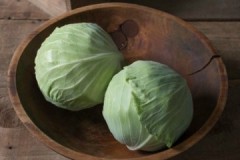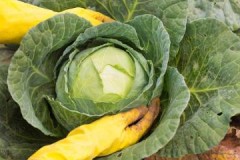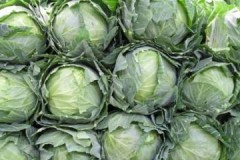A storehouse of vitamins: how to store Brussels sprouts until spring?
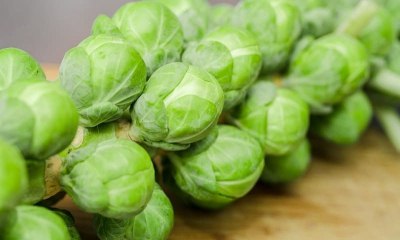 Brussels sprouts are considered the most beneficial member of the cruciferous family. It contains phosphorus and iron, vitamin C, PP, B1, B2, B6 and more.
Brussels sprouts are considered the most beneficial member of the cruciferous family. It contains phosphorus and iron, vitamin C, PP, B1, B2, B6 and more.
Every person who monitors their health should regularly include this vegetable in their diet.
Unfortunately, Brussels sprouts don't grow all year round. The harvest in Russia is traditionally harvested in the fall.
Read about how to properly store Brussels sprouts and get benefits from it until spring comes.
Content
Preparing for winter storage at home
Ensuring that Brussels sprouts are well kept is still needed at the harvesting stage.
Variety selection
Not all Brussels sprouts are stored equally well. This must be taken into account when choosing seeds for planting.
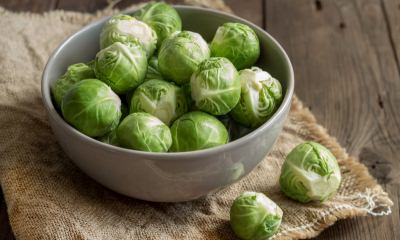 If you plan to store the harvest all winter, you should opt for varieties such as:
If you plan to store the harvest all winter, you should opt for varieties such as:
- Hercules;
- Casio;
- Curl;
- Sapphire;
- Sanda.
These varieties are late-ripening. They are harvested at the end of autumn. Such cabbage can remain in the beds even under snow.
Different varieties are kept separate from each other... Otherwise, you can lose the entire crop.
Vegetable preparation
You don't need to wash your cabbage to keep it fresh. The main thing is to sort vegetables by selecting rotten and soft specimens. For the winter, dense large heads of cabbage are left, the diameter of which is at least 3 cm. A couple of leaves are removed only from the lower forks, since most often they do not adhere well to them.
Loose and soft cabbage is not suitable for long-term storage. It needs to be processed first.
Methods and rules
Brussels sprouts are stored in a variety of ways. Heads of cabbage are frozen, lowered into the basement, buried in a trench... Each method has its own characteristics that you need to be aware of.
In the refrigerator fresh
In the refrigerator, Brussels sprouts are stored in the vegetable drawer. It would be wrong to just pile the heads of cabbage, they need to be packed.
Procedure:
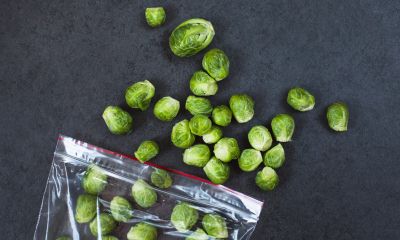 Forks are not washed, they are simply cleaned off the ground and sent to the refrigerator for 2-3 hours. During this time, they will cool down, due to which less condensation will accumulate in the bag.
Forks are not washed, they are simply cleaned off the ground and sent to the refrigerator for 2-3 hours. During this time, they will cool down, due to which less condensation will accumulate in the bag.- When the heads of cabbage have cooled, they are put into plastic bags, which are tied tightly, expelling excess air.
- With the help of a toothpick, several holes are made in them. They are necessary so that the cabbage can breathe, and moisture does not accumulate inside.
- The heads of cabbage prepared in this way are removed for storage.
In the refrigerator, Brussels sprouts will stay fresh for 2 months. A significant disadvantage of this storage method is that it will not work to put large volumes in the vegetable drawer.
A certain microclimate is created and maintained in the package, in which the heads of cabbage feel good and do not deteriorate for a long time.
In the freezer
Vegetables are stored in the freezer for the longest time. If done correctly, the cabbage will be edible throughout the year.
Procedure:
- Remove the heads of cabbage from the stem.
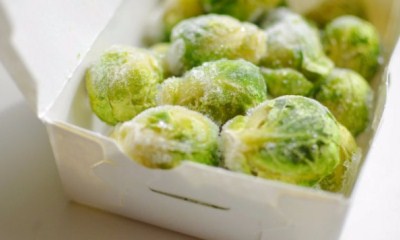 Soak them in cool salted water for 15 minutes. This will decontaminate the forks and expose the pests that often hide under the leaves. All lurking insects will float to the surface.
Soak them in cool salted water for 15 minutes. This will decontaminate the forks and expose the pests that often hide under the leaves. All lurking insects will float to the surface.- After 5 minutes, the forks are dipped in boiling water, and then in ice water.
- The heads treated in this way are laid on a paper towel to dry completely.
- Dry cabbage is placed in a container for storage, air is expelled from it and put into the refrigerator.
Heads of cabbage can be stored in a vacuum package, in ordinary plastic bags or in plastic containers.
If, after processing, you do not dry the cabbage, but immediately send it to the freezer, then its leaves will freeze. therefore definitely need to spend 15 minutes drying the forks.
How to freeze Brussels sprouts, video recipe:
In the basement
There are several options for storing Brussels sprouts in the basement, namely:
-
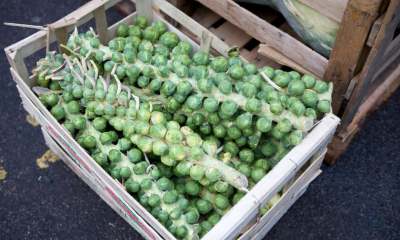 In limbo... In this case, the heads of cabbage are not removed from the stems, only the leaves are plucked from them. Hang them upside down.
In limbo... In this case, the heads of cabbage are not removed from the stems, only the leaves are plucked from them. Hang them upside down.When all the trunks are in place, they are wrapped in cling film. If condensation forms under it, it is changed. Otherwise, the vegetables will start to rot.
- In boxes of sand... Do not remove the roots from the stems for storage in the sand. Leaves are cut from them and planted in prepared containers. The sand needs to be slightly moistened.
- In bulk, in empty boxes... The forks are removed from the stems, cleaned of obvious dirt and placed in a clean container. The heads of cabbage should be located tightly to each other so that moisture evaporates from them as little as possible. The box is covered with cardboard from above. Do not seal it so that mold does not grow inside.
It is not recommended to wash the forks before sending the cabbage to the cellar. They are covered with a natural protective layer, the removal of which negatively affects the shelf life of the cabbage.
On the balcony
If there are no other options, the crop is left to winter on the balcony. This is possible provided that the loggia is glazed.
Outdoors, the cabbage will just freeze. While maintaining a stable temperature, it can be stored in sand, in cling film, on stems.
In the trench
This method saves space in the refrigerator and in the cellar. Features of storing a vegetable in a trench:
- Dig the entire bush out of the ground.
- Prepare the trench.
- Place the plants in it so that they do not come into contact with each other.
- Fill the trench with sand and insulate it with straw.
If the air temperature does not drop below -5 degrees and rise above +3 degrees, then the cabbage will remain fresh for 5 months.
Other options
Brussels sprouts are delicious not only fresh. Part of the harvested crop can be stored as blanks. There are excellent recipes for salting and pickling this healthy vegetable.
Salting
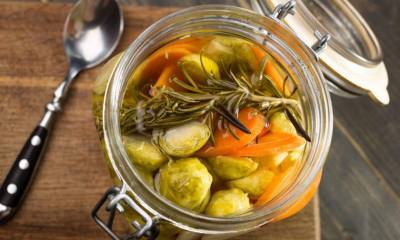 Small and dense heads of cabbage up to 4 cm in size are suitable for salting. The blanks require the following ingredients:
Small and dense heads of cabbage up to 4 cm in size are suitable for salting. The blanks require the following ingredients:
- cabbage - 1 kg;
- salt - 3 tbsp. l .;
- water - 1 l.
Step-by-step algorithm of actions:
- Rinse the cabbage and put it in boiling water for 3 minutes.
- Sterilize jars and put prepared heads of cabbage in them.
- Prepare the brine: bring the water to a boil, salt.
- Pour it into jars and close them with a nylon lid.
Store salted cabbage in the refrigerator. As such, it will remain edible for 4 months. If desired, allspice and garlic can be added to the brine.
Pickling
To marinate small forks, you need the following ingredients:
- cabbage - 1 kg;
- water - 1 l;
- sugar and salt - 2 tbsp each l .;
- ground black pepper - ½ tsp;
- table vinegar - 250 ml.
Cooking method:
- Rinse the cabbage, removing all impurities from it.
- Cut the forks into 2 pieces and tamp them in a sterilized jar.
- Prepare the marinade: add salt, pepper and sugar to boiling water.
- Pour boiling water over the cabbage, cover the jar with an iron lid and sterilize for 20 minutes.
- Roll up the cans, turn them upside down, cover with a blanket and wait until they cool completely.
Timing
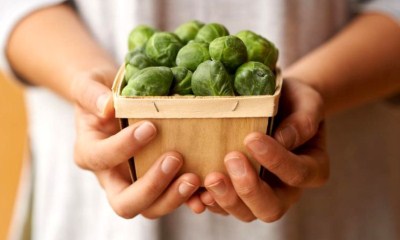 The shelf life will vary depending on storage conditions cabbage:
The shelf life will vary depending on storage conditions cabbage:
- at a temperature of + 3 ... + 5 degrees - 2 months;
- at a temperature of + 10 degrees - no more than a month;
- frozen - up to a year;
- in a cellar at a temperature of 0 ... + 3 degrees - up to 5 months.
Fresh cabbage is best stored in the refrigerator, in the cellar and in the trench.
Helpful information
To prevent Brussels sprouts from spoiling for as long as possible, you must adhere to the following recommendations:
- At least once a month, the harvest that has been stored in the cellar must be inspected. Rotten and diseased fruits are immediately discarded.
- Thawed Brussels sprouts cannot be re-frozen.
- If the vegetables did not have time to ripen in the garden before the onset of cold weather, there is no need to be upset. They are dug up together with the soil, placed in suitable containers and removed to heat, where they will "reach".
- Frozen cabbages do not need to be thawed before cooking. They are immediately dipped in boiling water or placed in a preheated frying pan.
You can learn about the storage of different varieties of cabbage from of this section.
Conclusion
There are several ways to store Brussels sprouts:
- in fridge,
- in the cellar,
- in the freezer and more.
If you correctly approach the issue of storing heads of cabbage, you can benefit from them until the onset of heat.

